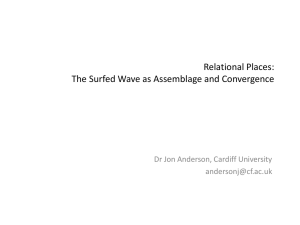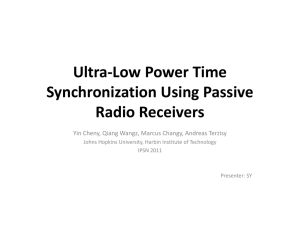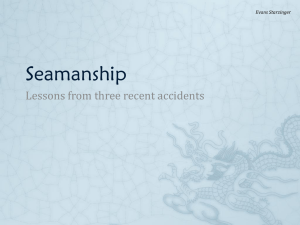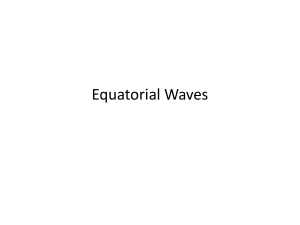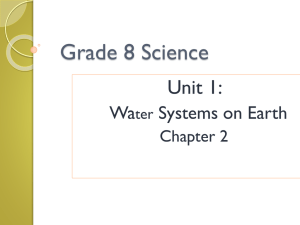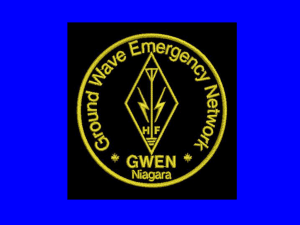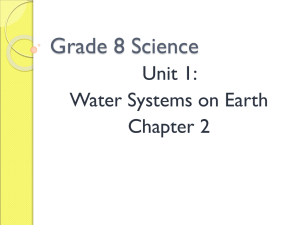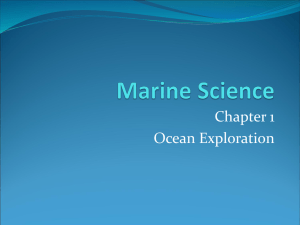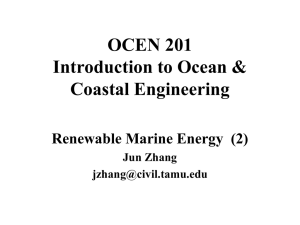Physical Oceanography - Navy STEM for the Classroom
advertisement
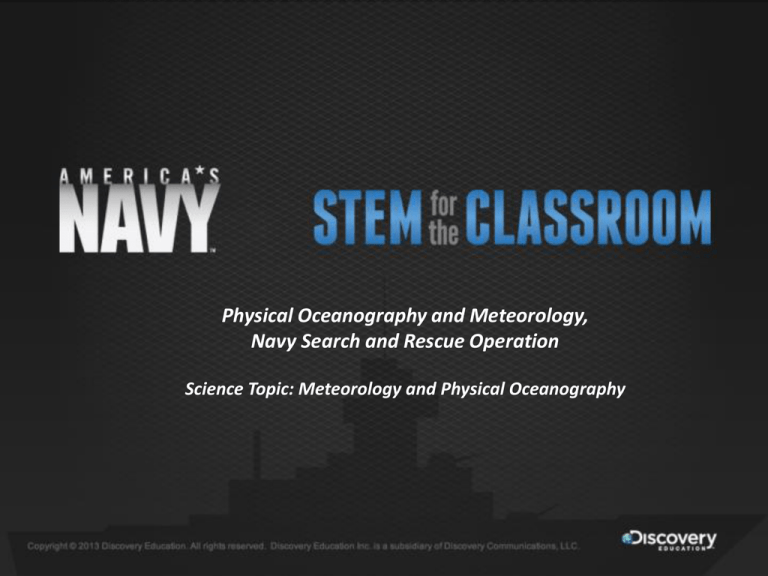
Physical Oceanography and Meteorology, Navy Search and Rescue Operation Science Topic: Meteorology and Physical Oceanography Physical Oceanography and Meteorology Navy Search and Rescue Operation Lesson Plan Oceans & Oceanography What is oceanography and what does the study of oceanography include? Physical Oceanography & Meteorology Physical Oceanography- the study of the physical properties, conditions, and processes of the ocean. This includes the motion of ocean waters, chemical properties of water, tidal circulation, and how the ocean and atmosphere affect each other. Meteorology-the study of the atmosphere; including weather observations, climatology, atmospheric chemistry and physics, and hydrology. Click the wave to watch a video about meteorology at sea (insert video of Sarah Allen) What technology is available to study physical oceanography and meteorology? Helps scientists and every day people understand meteorological conditions around the world. Buoys provide physical oceanographic information on the world’s oceans. Aids in navigation by showing trends in ocean motion, velocity, currents, convergence, and direction. Helps find location, roads, travel conditions, geographic features, weather, and buoy systems on the ocean. The U.S. Navy Video Notes: How do the physical and meteorological conditions of the ocean affect naval operations? Watch the video and see if you can find some ideas. Where on Earth are you? Can you find your location on Google Earth? Where is the nearest ocean? Under the “layers” section be sure to check out the Ocean tab and the Weather tab for ocean observation buoys. Under “View” turn on the Longitude and Latitude Grid and scale bar. What is your longitude and latitude where you are? What is your nearest ocean observation buoy? What is its longitude and latitude? What meteorological and oceanographic conditions is it measuring? Photo: NOAA’s National Buoy Data Center. Oceanographers measure in nautical miles (nm). What is a nautical mile? Under tools, set your ruler to measure in nautical miles (nm) and measure to the nearest shoreline. Remember: 1 nm = 6,076 ft = 1,852 m Search and Rescue (SAR) Scenario What do you need to know? You are now a US Naval Carrier Command Fleet of newly commissioned officers out of Annapolis, MD Naval Academy. You must work as a team to rescue a downed pilot in the Atlantic ocean. Weather at Sea Video Notes: Watch the video to learn more about the weather at sea. What factors might impact your search and rescue operation? Non-fixed wing aircraft Aircraft carrier On the Waves Littoral combat ship (LCS) Crest Crest Wave Length Wave Height Click the wave to watch a short video about measuring waves. Calm water level Longitudinal Wave (sound) Transverse Wave (water) Factors that Affect Water Waves • Wind speed • Fetch • Wind duration Trough Search and Rescue (SAR) Scenario Begin: 36°59'46.23"N Names of two buoys/stations along route: 75°59'37.22"W 1. Datum (location of lost pilot): 35°36'11.29"N 72° 2'39.43"W 2. Total nautical distance (nm) from start to datum: Remember: 1 nm=1,852 m Start Station Distance (nm): Long: Lat: Distance (nm): Long: Lat: Degrees of Course: Buoy Datum Distance (nm): Long: Lat: Wave Height • Which has a greater effect on wave height, wind speed or fetch? Why? • How do you think travel time will be affected by wave height and wind speed? Why? http://oceanservice.noaa.gov/education/lessons/ocean_motion_wksht.html Start Station Wind: 10 kts Fetch: 30 nm Wave height: ____________ Buoy Wind: 20 kts Fetch: 55 nm Wave height: ____________ Datum Wind: 25 kts Fetch: 150 nm Wave height: ____________ Getting There Wave Height (ft) Carrier Max Travel Speed (kt) Littoral Combat Ship Max Travel Speed (kt) 0-5 32 kt max 40 kt max 6-10 32 kt max 40 kt max 11-15 32 kt max 40 kt max 16-20 20 kt max 16 kt max 21+ 10 kt max 10 kt max Officer’s Notes: •If wave height is over 1/3 of the height of the bow of a ship then travel speed is severely restricted. •Actual maximum travel speeds of ships are classified, this is an approximation. •You will assume ships will travel maximum speed to reach the datum. Total Travel Time Carrier: LCS: Travel Speed: 1 knot (kt) = 1.852 km/hr = 1.151 mph Nautical Distance Traveled (DT) / Total Speed (kts) (S) = Time Start Station Travel Time Wave ht: Carrier: LCS: Buoy Travel Time Wave ht: Carrier: LCS: Datum Travel Time Wave ht: Carrier: LCS: Officer’s Notes: •Be sure to lay your maneuvering board so that the start point is in the middle and true north (0 degrees) is aligned with the top of your paper map. Instructors will turn the map so that true N is at the top of the screen. •For this exercise assume that the pilot went straight down at the datum. Calculate the drift of the pilot How many nautical miles did the pilot drift? Can you plot this on your maneuvering board and map? DD = CS x TD DD = Distance Drifted CS = Current Speed at present location TD = Amount of time pilot has been drifting NOTE: you will assume the amount of time the pilot has been drifting is the total travel time from the start of the exercise to how long it takes the fastest ship (LCS) to reach the datum (see your previous calculations). Gulf Stream Current (N and NE) for this exercise use due N. Officer’s Notes: •Assume current is going due North for this exercise. •Current Speed (CS )= 5 kt •How long was your pilot drifting? (Hint: use the total time it took for your carrier to get to the datum) Intercept Point Pilot’s Drift Time to Adjust for Current! How many nm did the pilot drift? How far (nm) is the new theoretical intercept course? What is the compass bearing of the theoretical intercept course? Intercept Point “What course do you tell your helmsman to steer and what speed?” Risk Analysis of SAR • Name and explain some of physical attributes of oceanography and meteorology that affect successful ocean navigation. • How do these affect navigating ships? • Does wind speed or fetch affect wave height the most? Why? • When navigating a course why can’t a ship steer in a straight line to reach its destination? • What technologies are available for successful and safe naval navigation? • Why is it important to know the mathematics and equations behind technology?



